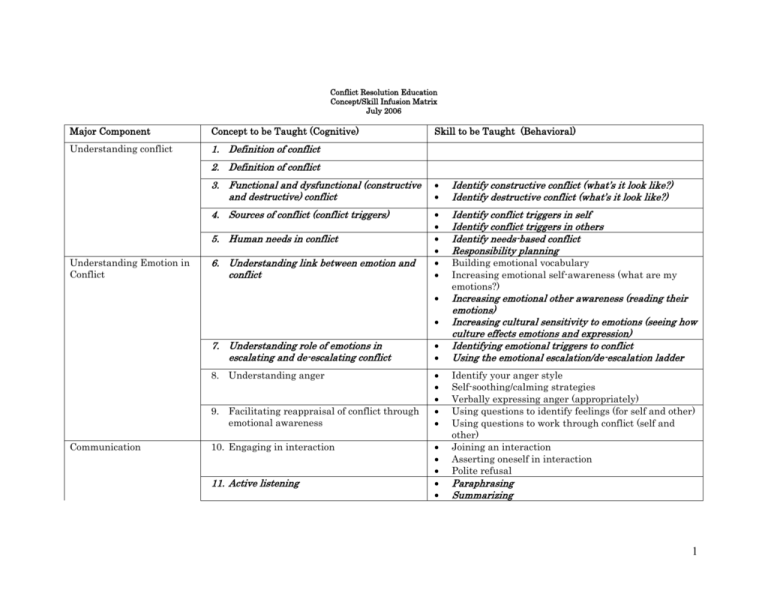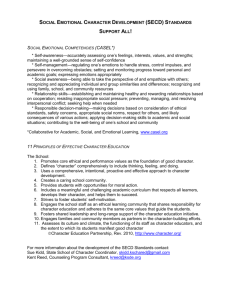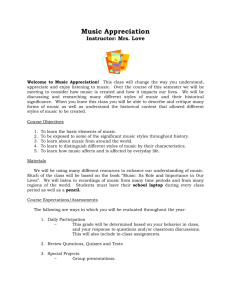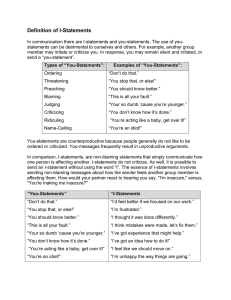crete - Conflict Resolution Education Connection
advertisement

Conflict Resolution Education Concept/Skill Infusion Matrix July 2006 Major Component Concept to be Taught (Cognitive) Understanding conflict 1. Definition of conflict Skill to be Taught (Behavioral) 2. Definition of conflict 3. Functional and dysfunctional (constructive and destructive) conflict Identify constructive conflict (what’s it look like?) Identify destructive conflict (what’s it look like?) 4. Sources of conflict (conflict triggers) Identify conflict triggers in self Identify conflict triggers in others Identify needs-based conflict Responsibility planning Increasing emotional other awareness (reading their emotions) Increasing cultural sensitivity to emotions (seeing how culture effects emotions and expression) Identifying emotional triggers to conflict Using the emotional escalation/de-escalation ladder 5. Human needs in conflict Understanding Emotion in Conflict 6. Understanding link between emotion and conflict 7. Understanding role of emotions in escalating and de-escalating conflict 8. Understanding anger 9. Facilitating reappraisal of conflict through emotional awareness Communication 10. Engaging in interaction 11. Active listening Building emotional vocabulary Increasing emotional self-awareness (what are my emotions?) Identify your anger style Self-soothing/calming strategies Verbally expressing anger (appropriately) Using questions to identify feelings (for self and other) Using questions to work through conflict (self and other) Joining an interaction Asserting oneself in interaction Polite refusal Paraphrasing Summarizing 1 12. Effective questioning 13. I-Statements 14. Defensive communication 15. Verbal aggression 16. Confirming and disconfirming behavior 17. Nonverbal communication 18. Cultural difference in communication Problem-Solving Listening for Feelings Perception Checking Supporting and Encouraging Messages Using Neutral Language Seeing relational bids Sending confirming messages Avoiding disconfirming messages Counteracting disconfirming messages Reading NV behaviors Sending NV behaviors Recognizing NV triggers in conflict Adjusting to Cultural Differences in NV Communication (using space, voice, gesture and body orientation in a culturally sensitive way) Conducting dialogue processes, circle processes 19. Dialogue processes 20. Effective decision making 21. Achieving consensus 22. Perspective taking 23. Conflict styles Open v. Closed Questions Appreciative Inquiry I-Statements Nonaggressive communication (complaint v. criticism v. contempt) Adjusting to Cultural Differences in Language (using direct and indirect language well) Steps in decision making Leading group discussions for decision making Testing options for effective decisions Developing realistic implementation plans for decisions Learning six levels of consensus Facilitating group discussion to consensus Recognizing emotional and cognitive perspectives Counteracting hostile attributions Effective questioning to assess perceptions Recognizing conflict styles 2 Matching conflict styles to the situation Being competent at enacting all conflict styles Recognizing interests and positions Questioning to uncover interests behind positions Exploring options/brainstorming Principled negotiation 28. Classroom management styles 29. Creating collaborative community in the classroom Recognizing your classroom management style Matching a classroom management style to teaching situations Creating class officers Negotiating class rules Using class meetings Recognizing discipline and punishment Developing logical consequences for behaviors Using non-punitive language 24. Interest-based negotiation 25. Competitive negotiation 26. Alternatives to agreement 27. Mediation Conflict Management as a Classroom Tool 30. Cooperative discipline Academic Infusion Developing good positions Creating sound arguments Competing without being cutthroat Identifying a BATNA Identifying a WATNA Mediation 31. Understanding the philosophy of CRE infusion 32. Discipline potential for infusion 33. Multiple learning styles Creating a Comprehensive School Conflict Management Program 34. Research proven practices in CRE 35. Understanding systems dynamics 3 36. Understanding possible components of a comprehensive school conflict management program 37. Using needs assessment for strategic planning 38. System Evaluation for Improvement Copyright 2005. Created by Dr. Tricia Jones, Temple University. E-mail: tsjones@temple.edu. Used with permission. Regular Text Indicates Concepts and Skill Areas Still to be Covered in Training Bold-faced and Italicized Text Indicates Material Already Covered in CRETE Year 1and Year 2 Training 4






